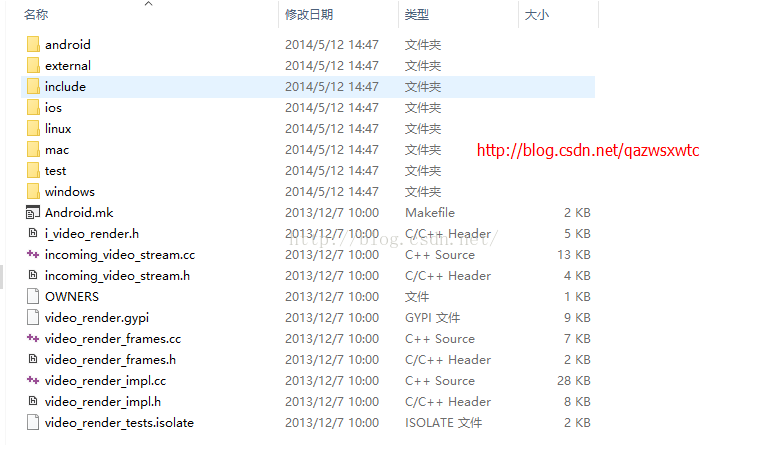此部分为webrtc视频渲染显示,代码结构如下:

其实此部分代码与《webrtc视频引擎之vedio_capture_module介绍》的代码结构一样
1,图中能够直接看到的.h和.cc文件也是一个适配作用,用于根据系统平台适配采用某部分进行视频渲染;
2, android文件夹用于在android平台渲染显示视频图像;
3, IOS文件夹用于在IOS平台渲染显示视频图像;
4, linux文件夹用于在linux平台渲染显示视频图像;
5, mac文件夹用于在mac平台渲染显示视频图像;
6,windows文件夹用于在windows平台渲染显示视频图像;
render图像显示模块的接口类:
在调用该接口类创建实例对象的时候需要从构造函数传入 相关的显示参数, 如下:
const int32_t id, //本路显示视频的ID,用户自定义,用于唯一区分本路视频即可
const VideoRenderType videoRenderType, // 此定于如下枚举<pre name="code" class="cpp">enum VideoRenderType
{
kRenderExternal = 0, // External
kRenderWindows = 1, // Windows
kRenderCocoa = 2, // Mac
kRenderCarbon = 3,
kRenderiOS = 4, // iPhone
kRenderAndroid = 5, // Android
kRenderX11 = 6, // Linux
kRenderDefault
};
void* window, //用于显示视频的窗口对象指针
const bool fullscreen //是否需要全屏显示
ModuleVideoRenderImpl(const int32_t id, const VideoRenderType videoRenderType, void* window, const bool fullscreen);该接口还是StartRender 、StopRender等接口供外部调用控制视频渲染
</pre><pre code_snippet_id="1842801" snippet_file_name="blog_20160821_7_7573210" name="code" class="cpp">class ModuleVideoRenderImpl: public VideoRender
{
public:
/*
* VideoRenderer constructor/destructor
*/
ModuleVideoRenderImpl(const int32_t id,
const VideoRenderType videoRenderType,
void* window, const bool fullscreen);
virtual ~ModuleVideoRenderImpl();
/*
* Change the unique identifier of this object
*/
virtual int32_t ChangeUniqueId(const int32_t id);
virtual int32_t TimeUntilNextProcess();
virtual int32_t Process();
/*
* Returns the render window
*/
virtual void* Window();
/*
* Change render window
*/
virtual int32_t ChangeWindow(void* window);
/*
* Returns module id
*/
int32_t Id();
/**************************************************************************
*
* Incoming Streams
*
***************************************************************************/
/*
* Add incoming render stream
*/
virtual VideoRenderCallback
* AddIncomingRenderStream(const uint32_t streamId,
const uint32_t zOrder,
const float left, const float top,
const float right, const float bottom);
/*
* Delete incoming render stream
*/
virtual int32_t
DeleteIncomingRenderStream(const uint32_t streamId);
/*
* Add incoming render callback, used for external rendering
*/
virtual int32_t
AddExternalRenderCallback(const uint32_t streamId,
VideoRenderCallback* renderObject);
/*
* Get the porperties for an incoming render stream
*/
virtual int32_t
GetIncomingRenderStreamProperties(const uint32_t streamId,
uint32_t& zOrder,
float& left, float& top,
float& right, float& bottom) const;
/*
* Incoming frame rate for the specified stream.
*/
virtual uint32_t GetIncomingFrameRate(const uint32_t streamId);
/*
* Returns the number of incoming streams added to this render module
*/
virtual uint32_t GetNumIncomingRenderStreams() const;
/*
* Returns true if this render module has the streamId added, false otherwise.
*/
virtual bool HasIncomingRenderStream(const uint32_t streamId) const;
/*
*
*/
virtual int32_t
RegisterRawFrameCallback(const uint32_t streamId,
VideoRenderCallback* callbackObj);
virtual int32_t GetLastRenderedFrame(const uint32_t streamId,
I420VideoFrame &frame) const;
virtual int32_t SetExpectedRenderDelay(uint32_t stream_id,
int32_t delay_ms);
/**************************************************************************
*
* Start/Stop
*
***************************************************************************/
/*
* Starts rendering the specified stream
*/
virtual int32_t <span style="color:#ff0000;">StartRende</span>r(const uint32_t streamId);
/*
* Stops the renderer
*/
virtual int32_t <span style="color:#ff0000;">StopRender</span>(const uint32_t streamId);
/*
* Sets the renderer in start state, no streams removed.
*/
virtual int32_t ResetRender();
/**************************************************************************
*
* Properties
*
***************************************************************************/
/*
* Returns the prefered render video type
*/
virtual RawVideoType PreferredVideoType() const;
/*
* Returns true if the renderer is in fullscreen mode, otherwise false.
*/
virtual bool IsFullScreen();
/*
* Gets screen resolution in pixels
*/
virtual int32_t
GetScreenResolution(uint32_t& screenWidth,
uint32_t& screenHeight) const;
/*
* Get the actual render rate for this stream. I.e rendered frame rate,
* not frames delivered to the renderer.
*/
virtual uint32_t RenderFrameRate(const uint32_t streamId);
/*
* Set cropping of incoming stream
*/
virtual int32_t SetStreamCropping(const uint32_t streamId,
const float left, const float top,
const float right, const float bottom);
virtual int32_t ConfigureRenderer(const uint32_t streamId,
const unsigned int zOrder,
const float left, const float top,
const float right, const float bottom);
virtual int32_t SetTransparentBackground(const bool enable);
virtual int32_t FullScreenRender(void* window, const bool enable);
virtual int32_t SetBitmap(const void* bitMap,
const uint8_t pictureId,
const void* colorKey,
const float left, const float top,
const float right, const float bottom);
virtual int32_t SetText(const uint8_t textId,
const uint8_t* text,
const int32_t textLength,
const uint32_t textColorRef,
const uint32_t backgroundColorRef,
const float left, const float top,
const float right, const float bottom);
virtual int32_t SetStartImage(const uint32_t streamId,
const I420VideoFrame& videoFrame);
virtual int32_t SetTimeoutImage(const uint32_t streamId,
const I420VideoFrame& videoFrame,
const uint32_t timeout);
virtual int32_t MirrorRenderStream(const int renderId,
const bool enable,
const bool mirrorXAxis,
const bool mirrorYAxis);
private:
int32_t _id;
CriticalSectionWrapper& _moduleCrit;
void* _ptrWindow;
bool _fullScreen;
IVideoRender* _ptrRenderer;
typedef std::map<uint32_t, IncomingVideoStream*> IncomingVideoStreamMap;
IncomingVideoStreamMap _streamRenderMap;
};有兴趣的同学朋友可以自行去研究每个设备是怎么显示视频, 至于每个设备如何显示视频这个后面都单独介绍,这里只做个整体的介绍。
版权声明:本文为qazwsxwtc原创文章,遵循 CC 4.0 BY-SA 版权协议,转载请附上原文出处链接和本声明。